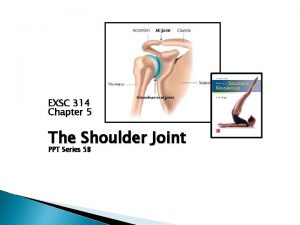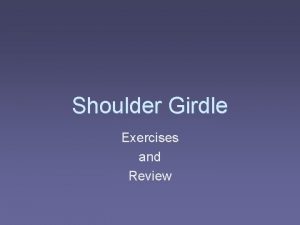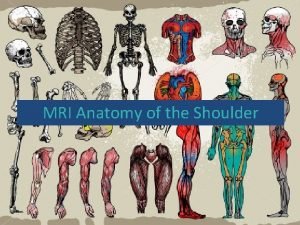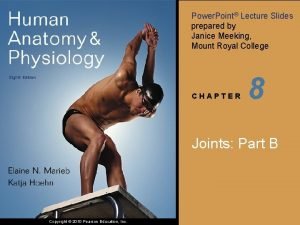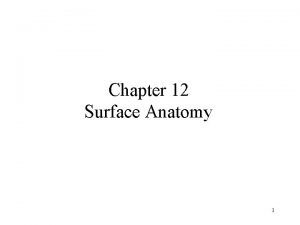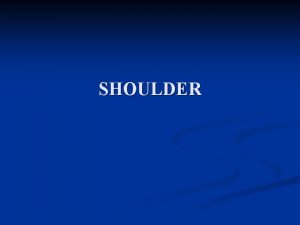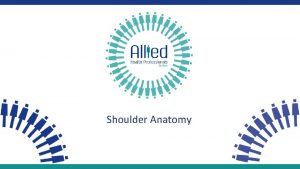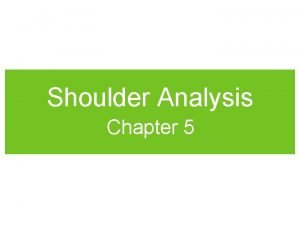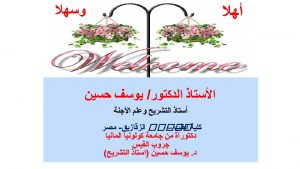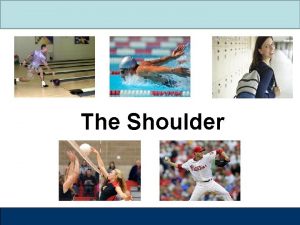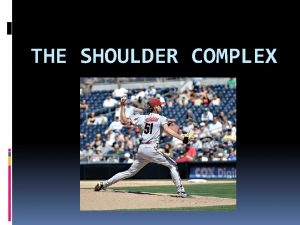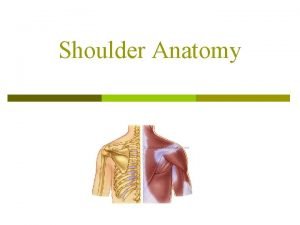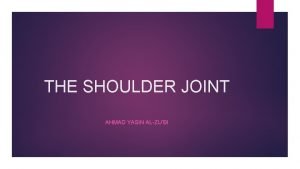Shoulder Anatomy How the shoulder works 01 The













- Slides: 13

Shoulder Anatomy

How the shoulder works 01 The shoulder is the most complex /sophisticated joint in the body because: Text 002 Text 003 • It allows the greatest range of moment of any joint in the body • It has a series of complex muscles and ligaments that keep it in joint • It is made up of 4 joints and 5 linked bone groups which all work together • To allow movement the joints need to be free ‘unstable’ compared to the other joints in the body

Bones of the shoulder The bones of the shoulder consist of: • The Humerus (upper arm bone) • The Scapula (shoulder blade) • The Clavicle (collar bone) Text 003

Joints of the shoulder 4 Joints make up the shoulder: • Glenohumeral Joint • Acromioclavicular Joint • Sternoclavicular Joint • Scapulothoracic Joint bone) Text 003

The Glenoid • The ball on the Humerus sits in the socket on the Scapula ‘The Glenoid’ • The ball does not fit exactly which allows increased movement • Stability is provided by muscle & ligaments Text 003

Glenoid Labrum • The socket of the shoulder is deepened by the Glenoid Labrum • It is similar to the Meniscus in the knee • An injury to the shoulder can result in damage to the ‘Labrum-’Labral tear Text 003

Shoulder Bursae • Bursae are found where ever 2 body parts move against one another to reduce friction • It contains a small amount of lubricating fluid • Inflammation & swelling of the Bursae are known as Bursitis Text 003

Ligaments & Tendons of the shoulder 01 • The structure of the shoulder is given stability by all our Ligaments that surround the area from front and back aspects. Text 002 Text 003 • We have a similar connective tissue known as a Tendon, which is designed to withstand tension and are both made from collagen but our Ligaments connect bone to bone were as Tendons connect muscle to bone.

Muscles of the shoulder During the shoulder class we work on exercises that are going to help support the shoulder structure as a whole, that’s why it is so important to look at the big picture of muscles that surround the area too. Exercise can also be felt in areas such as the chest, back and arm muscles, this is because they pair with our shoulder muscles to provide support and stability, hopefully this can make day to day/occupational tasks pain free or easier to do because the structure is working well together by not just isolating one specific area to strengthen.

4 Rotator Cuff muscles work around the shoulder blade (Scapula): • Supraspinatus • Infraspinatus • Subscapularis • Teres Minor b Together these help to stabilize the shoulder Text 003

Posterior Muscles of the shoulder Text 003

Anterior Muscles of the shoulder Text 003

Nerves of the arm • Nerves travel down the arm under the axilla (arm pit) • They are known as the Brachial Plexus • These nerves carry signals from the brain to muscle to move the arm • Nerves carry signals back to the brain about sensation Text 003
 Safety at street works and road works
Safety at street works and road works Shoulder complex ppt
Shoulder complex ppt Shoulder dislocation exercise bodybuilding
Shoulder dislocation exercise bodybuilding Cavitas glenoidalis
Cavitas glenoidalis Is type 1 acromion serious?
Is type 1 acromion serious? Shoulder anatomy
Shoulder anatomy Shoulder surface anatomy
Shoulder surface anatomy Fecboak
Fecboak đặc điểm cơ thể của người tối cổ
đặc điểm cơ thể của người tối cổ Các môn thể thao bắt đầu bằng tiếng chạy
Các môn thể thao bắt đầu bằng tiếng chạy Các châu lục và đại dương trên thế giới
Các châu lục và đại dương trên thế giới Hình ảnh bộ gõ cơ thể búng tay
Hình ảnh bộ gõ cơ thể búng tay Thế nào là hệ số cao nhất
Thế nào là hệ số cao nhất Hệ hô hấp
Hệ hô hấp

